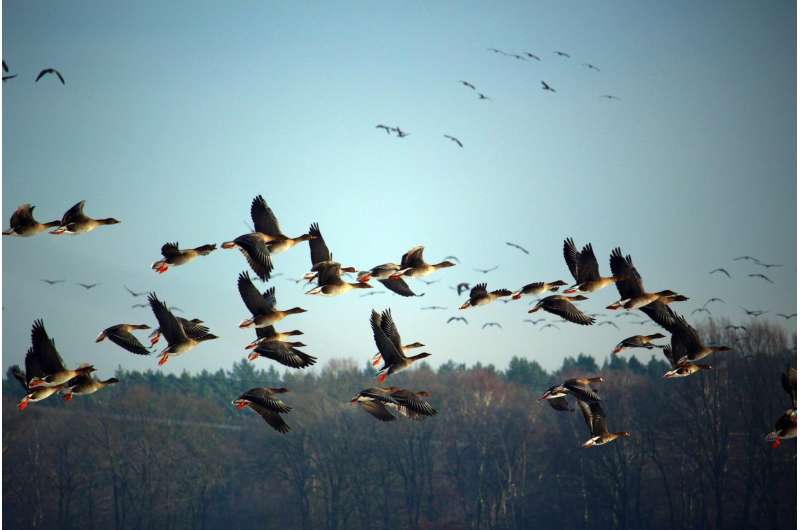Scientists determine how birds soar to great heights

Migratory birds often use warm, rising atmospheric currents to gain height with little energy expenditure when flying over long distances.
It's a behavior known as thermal soaring that requires complex decision-making within the turbulent environment of a rising column of warm air from the sun baked surface of the earth.
But exactly how birds navigate within this ever-changing environment to optimize their thermal soaring was unknown until a team of physicists and biologists at the University of California San Diego took an exacting computational look at the problem.
In this week's online version of the journal Proceedings of the National Academy of Sciences, the scientists demonstrated with mathematical models how glider pilots might be able to soar more efficiently by adopting the learning strategies that birds use to navigate their way through thermals.
"Relatively little is known about the navigation strategies used by birds to cope with these challenging conditions, mainly because past computational research examined soaring in unrealistically simplified situations," explained Massimo Vergassola, a professor of physics at UC San Diego.
To tackle the problem, he and his colleagues, including Terrence Sejnowski, a professor of neurobiology at the Salk Institute and UC San Diego, combined numerical simulations of atmospheric flow with "reinforcement learning algorithms"—equations originally developed to model the behavior and improved performance of animals learning a new task. Those algorithms were developed in a manner that trained a glider to navigate complex turbulent environments based on feedback on the glider's soaring performance.
According to Sejnowski, the "reinforcement learning architecture" was the same as that used by Google's DeepMind AlphaGo program, which made headlines in 2016 after beating the human professional Go player Lee Sedol.
When applying it to soaring performance, the researchers took into account the bank angle and the angle of attack of the glider's wings as well as how the temperature variations within the thermal impacted vertical velocity.
"By sensing two environmental cues—vertical wind acceleration and torque—the glider is able to climb and stay within the thermal core, where the lift is typically the largest, resulting in improved soaring performance, even in the presence of strong turbulent fluctuations," said Vergassola. "As turbulent levels rise, the glider can avoid losing height by adopting increasingly conservative, risk-averse flight strategies, such as continuing along the same path rather than turning."
In the two, three dimensional color graphs (shown above), the scientists illustrate how an untrained glider (at left) takes random decisions and descends, while the trained glider (at right) learns to employ the characteristic spiraling patterns in regions of strong ascending currents, as observed in the thermal soaring of birds and gliders. (The colors indicate the vertical wind velocity experienced by the glider. The green and red dots indicate the start and the end points of the trajectory, respectively.)
The researchers write in their paper that, based on their study, "torque and vertical accelerations" appear to be the sensorimotor cues that most effectively guide the most efficient soaring path of birds through thermals, rather than differences in temperature.
"Temperature was specifically shown to yield minor gains," they write adding that "a sensor of temperature could then be safely spared in the instrumentation for autonomous flying vehicles."
"Our findings shed light on the decision-making processes that birds might use to successfully navigate thermals in turbulent environments," said Vergassola. "This information could guide the design of simple mechanical instrumentation that would allow autonomous gliders to travel long distances with minimal energy consumption."
"The high levels of soaring performance demonstrated in simulated turbulence could lead to the development of energy efficient autonomous gliders," said Sejnowski, who is also a Howard Hughes Medical Institute Investigator.
More information: Learning to soar in turbulent environments, PNAS, www.pnas.org/cgi/doi/10.1073/pnas.1606075113
Journal information: Proceedings of the National Academy of Sciences
Provided by University of California - San Diego


















